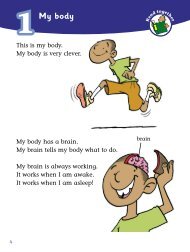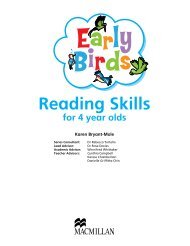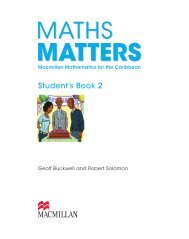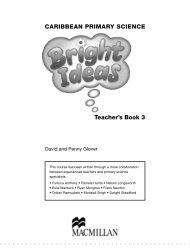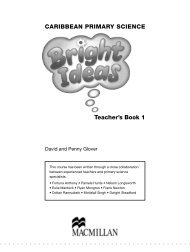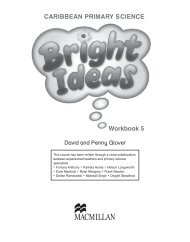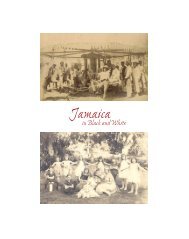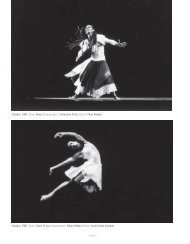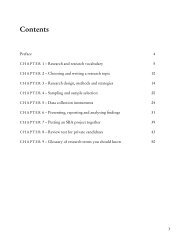Unit New School Introduction - Macmillan Caribbean
Unit New School Introduction - Macmillan Caribbean
Unit New School Introduction - Macmillan Caribbean
Create successful ePaper yourself
Turn your PDF publications into a flip-book with our unique Google optimized e-Paper software.
<strong>Introduction</strong><strong>Unit</strong><strong>New</strong> <strong>School</strong>English Matters is a series written specificallyfor the <strong>Caribbean</strong> which incorporates therequirements of the latest teaching syllabusesacross the region and integrates the differentaspects of English language learning. Studentsare introduced to a stimulating range of literaryand factual texts from different regions of the<strong>Caribbean</strong> and other parts of the English speakingworld. Through studying these texts, they developthe skills of listening, speaking, comprehensionand writing. These skills are supported by regularand frequent language practice and vocabularydevelopment. The emphasis throughout thecourse is on skill building so that students becomeincreasingly able to take responsibility for theirown learning.The course consists of a Student’s Book for eachlevel, consisting of 18 units with three revisionunits, and a Workbook giving additional practicein the skills taught in each unit. Each unit issupplemented by an Enrichment section whichcontains material to challenge more able studentsand gives them the chance to explore the topicof the unit further. A Reference Section at theend of the Student’s Book includes notes onimportant grammar points and a glossary. Thissection supports the information given in the mainsection of the book and helps students becomeindependent learners.Teacher’s Books at each level provide step bystep guidance in conducting the activities in theStudent’s Book. This guidance takes the formof suggestions for the teacher but is in no wayprescriptive. It offers alternatives to experiencedteachers who may be looking for a fresh approach,and support for less experienced teachers, whomay be approaching the syllabus for the first time.Teacher’s Books provide answers for the exercisesin the Student’s Book and the Workbook. A CDwith recordings of the listening exercises is alsosupplied.IntegrationThe units in the Student’s Books follow a regularpattern and are divided into five sections:• Listening and Speaking• Reading and Responding• Language Matters• Words Matter• WritingEach unit focuses on a specific topic beginningwith a section practising aural comprehensionand oral expression, followed by readingcomprehension leading to the developmentof the written language. Within each sectionopportunities for integrating the different skills canbe found, for example:- a listening exercise can give rise to a pair or groupdiscussion followed by writing a report on thetopic discussed.- reading a newspaper article on a controversialsubject can lead to a class debate, followed by aformal letter expressing a point of view.OutcomesThe content of each unit is outlined in the Scopeand Sequence and the expected outcomes for eachunit are clearly stated at the beginning of each unitin the Teacher’s Book. Teachers may find it helpfulto share these outcomes with their students at thebeginning of each unit in order to give them a clearsense of purpose.Listening and SpeakingA wide variety of recordings set in differentcontexts gives students the opportunity to developtheir listening skills. Different techniques arepractised, for example: listening for gist and for1
specific information, distinguishing betweenrelevant and irrelevant material, note taking,picking out key words. Extension exercises allowstudents to make use of what they have heard in adifferent context.Although they are often presented separately,speaking activities follow on directly from whathas been heard in the listening exercises and givestudents practice in pair and group discussion,giving short presentations on topics they haveresearched or giving and defending opinions.From the first the importance of good speakinghabits is stressed and students are encouraged tocontribute positively to group discussion and tolisten respectfully to others.Reading and RespondingReadingThe range of genres presented exposes students totraditional and contemporary fiction and poetry,descriptive and expository writing, web pages, andpersuasive material including advertisements andbrochures. Students are encouraged to developuseful pre-, during and post-reading strategies whichhelp them to get the most out of the texts they read.Teachers will need to assess their students’ readingability and take any necessary remedial action.More able readers could work on the Enrichmentexercises, while teachers give focused attention tothose who are experiencing difficulties. If there isa wide range of abilities within one class, a lunchtimeor after-school reading club could be createdwith more able students acting as facilitators.ComprehensionEach reading passage is followed by a set ofquestions students can answer independently inclass or for homework. Higher order questions areincluded from the start and students are taughtto distinguish between literal and inferentialquestions. A second set of questions intendedprimarily for discussion is also included. TheTeacher’s Book provides suggested answers forthe comprehension questions, but other answersmay be equally valid. This is left to the teacher’sdiscretion.From close study of the reading texts students alsolearn to improve their writing skills through usingvaried vocabulary and forming well-constructedtopic sentences and paragraphs. The texts are alsoused to help students develop summarising skills.Language MattersMany of the points practised in this section willalready be familiar to students even though theymay still make mistakes with them. It is important,therefore, that they do not feel that they are merelygoing over old ground. The Student’s Book andWorkbook provide a lively range of exercises set ina real life context, beginning with oral practice andmoving to written work. The Teacher’s Book notessuggest engaging students actively in the process bydrawing on their prior knowledge and encouragingthem to write their own rules and examples.Getting them to teach the point to another studentis an excellent way of checking comprehension.Words MatterStudents practise different techniques forunderstanding unfamiliar words, such as contextor word formation, and learn to develop theirown vocabulary through effective dictionarywork, recording of new words, word building andsynonym exercises. The exercises in the Student’sBook are supplemented by further exercises in theStudent’s Workbook.WritingThis section covers the mechanics of writing, suchas paragraphing, punctuation and proof reading.A variety of different writing tasks is included inBook 1, including formal and informal letters,2
stories, descriptions of people and places, simpleadvertisements, dialogue and reports. Persuasiveand argumentative writing is introduced, but willbe more fully developed in Books 2 and 3.The writing process is carefully explained anddeveloped. Students learn how to plan their workand to organise the material they have preparedinto well constructed paragraphs. They areencouraged to take greater responsibility for theirwork through peer discussion and review, and byediting and revising their own work.EnrichmentTwo supplementary pages for each unit areprovided at the end of the book directly after themain units. The material on these pages is directlyrelated to the themes of the main units, but oftena different approach is adopted. The activities onthese pages can be used to stimulate more ablelearners, who may be able to work through themindependently while others complete the activitiesin the main units. They can also be used to provideinteresting additional material for whole classteaching.WorkbookEach unit in the Workbook consolidates thecomprehension, language, vocabulary and writingexercises in the Student’s Book. The activities inthe Workbook can be used for different purposes,for example:- in class when you want students to get on withsomething quietly while you give focused attentionto individuals or small groups.- to consolidate work from the Student’s Book.- as a homework to follow up work done in class.- as practice tests.The icon in the Teacher’s Book identifies sectionsin the Workbook which are directly linked toactivities in the Student’s Book.AssessmentSelf AssessmentThe activities in the course book help studentsto become independent learners and to assumeresponsibility for their own work. Frequentopportunities are given for them to check theirown work and to assess their own progress. Each ofthe Review and Practice units provides them with achecklist which they discuss with another studentin order to evaluate their progress.Peer EvaluationStudents are expected to work in pairs to assesseach other’s work before producing a final copy.They are encouraged to focus on positive aspectsof their partner’s work as well as suggestingimprovements.Teacher AssessmentMuch of the assessment conducted by teacherswill be informal and is done through monitoringstudents as they move through the activities andproviding extra support where necessary. Wherethere is a need for more formal assessment, this canbe done by allocating marks to written exercises orby using the Review and Practice units or relevantWorkbook units as formal tests.Classroom ManagementThe Student’s Book contains a wealth of interactivetasks designed to be carried out in pairs or smallgroups. Many students entering secondary schoolsmay be used to a more teacher-led approach. It isimportant to lay down clear ground rules from thestart, such as staying on task and giving everyonea chance to speak. Make sure that students fullyunderstand what they are supposed to be doingand have a clear target to give a focus to theirdiscussions, such as reporting back to the classor producing two points for and two against astatement.3
Information TechnologyJudicious use of IT can be very beneficial tothe development of English language skills andgenerally elicits a positive response from students.As access to IT is increasing rapidly, the Student’sBook contains frequent suggestions for making useof this valuable tool. Using IT to save and edit workcan form part of the writing process for students,and tools such as an electronic thesaurus helpthem to increase their vocabulary. Most units inthe Student’s Book provide ideas for using IT in aninteresting way, such as creating posters and flyers,or recording the results of student surveys in tables.Guidance on using the Internet and writing e-mailsis also included.There are numerous web sites where teacherscan find interactive language exercises or studentworksheets to enrich their classroom teaching.The Teacher’s Book does not suggest any specificweb site addresses as these are likely to change.Using a search engine like Google and typing in thename of the desired topic will produce a numberof possible sources of material which can be usedwith students.4
<strong>Unit</strong>1<strong>New</strong> <strong>School</strong>Outcomes: By the end of <strong>Unit</strong> 1, students should be able to••listen to a short talk and record key information.••ask other students questions and present them to the class.••read an extract from a novel and answer recall and inferential questions.••identify nouns, verbs and adjectives in sentences.••use the verb to be correctly in the simple present and past tenses.••write definitions of selected words and record them in a vocabulary notebook.••complete a transactional form.••write a paragraph introducing themselves to their new teacher.Listening (page 100)Teaching TipStress the importance of listening for apurpose. Tell students to read the questionscarefully before they listen so they know whatthey need to find out. Are they listening forgist (the general idea) or for specific details?Establish a few ground rules, e.g.- Never interrupt while the tape is playing.- Keep writing to a minimum while listening.1. Discuss why listening is such an important partof the study of the English language.2. Lead into the activity by discussing briefly whatstudents need to know at the beginning of anew school year.3. Play or read the first two extracts straightthrough once. Play or read them again, thengive students time to note down the answers.4. Students copy the table before they listen to thethird extract. They note answers as before.ExtensionStudents compare what they heard with whathappens in their own school. Pairs prepare a shortintroductory talk giving information for newstudents at their school.AnswersExercise 1: 1. c (punctuality), 2. b (lunch times),Exercise 2: 1a. 7.30, 7.45, 8.15, 1b. The caretakerwill report you to the Vice Principal. 2a. 12.00 2b.classroom/ school yard, 2c. drinks and snacks, 2d.line up quietly outside the classrooms.Exercise 3: Tuesday: football practice,Wednesday: girls’ football practice, Thursday: trialsfor new students, Friday: no clubsSpeaking (page 11)1. Ice breaker: Use this as an opportunity to learnyour students’ names and to get them used toparticipating in class. List the adjectives theyuse to describe themselves and discuss whichones are the most interesting.2. Getting to know you: Elicit questions whichstudents could ask to find out more aboutpeople they do not know. Emphasise theimportance of speaking clearly and courteously.Reading and Responding (Pages 12-13)Teaching TipUse this opportunity to assess your students’reading comprehension. Tell them to read thefirst part of the reading passage silently, thenask a few recall questions, e.g. Why did Anniewalk to school alone? Repeat for the secondpart of the text. Once you have assessed theirability, you can decide how much supportthey will need. Decide on how to group thembased on their needs for future .5
1. Introduce the text briefly. Students look at thepicture and skim the text to find the answers tothe pre-reading questions.2. Students read the text silently and then aloudin pairs or small groups. Move around the classto monitor. Make a note of those who are notfluent readers.3. Students answer the comprehension questions.The first set of questions can be answered inwriting. The second set should be discussed inpairs or small groups.AnswersExercise 1a: 1. 12 years old 2. They were wearingthe same uniform. 3. She had been to the schoolthe week before. 4. for morning prayers and hymnsinging/ to listen to a talk from the Principal 5. b 6words the girls whispered to one anotherExercise 1b: (Suggested answers) 1, lonely/left out. The other students knew one anotherand were talking and laughing together. 2. Itemphasises the fact that Annie is a new student. 3.They smiled at her but they did not speak to her ortry to include her. 4. open answersExercise 2: 1c, 2b, 3b, 4dLanguage Matters (Pages 14-15)Parts of Speech1. Exercises 1 and 2: Students should alreadyknow how to identify and define nouns, verbsand adjectives. Lead into the activities in theStudent’s Book by asking students to- write their own definitions for nouns,adjectives and verbs.- write three examples of each one.Students compare the definitions they wrotewith the ones in the Student’s Book andcomplete exercise 2.2. Read the information in the grammar box.Remind students that the same word cansometimes be used as more than one part ofspeech. Students write answers to Exercise 3a,3b.ExtensionStudents use their dictionaries to find 3 morewords which can be used as more than one part ofspeech and write example sentences.AnswersExercise 1: noun: refers to a person, place, thing orquality, verb: describes actions or states, adjective:describes a person, place, thing or qualityExercise 2: 2, shoulder, bag, 3. orderly, silent,empty, 4. formed, filed, 5. Headmistress, students,6,old, good, newExercise 3: 3a. 1. noun 2. verb 3. noun 4. verb 5.verb 6. verb 7. noun 8. verbThe verb ‘to be’1. Lead into the activity by listing differentsubjects for verbs, e.g. I, my parents, everyone.Then write a list of adjectives and adjectivalphrases, e.g. honest, good at sports, very tall.Students make sentences using the correct formof the verb ‘to be’, e.g. She is very tall.2. Discuss students’ sentences, then let them workthrough the exercises independently.Answers:Exercise 1a/b: open answersExercise 3: 1. was, 2.were, 3. was, 4. was, 5. were, 6.was, 7. was, 8. was, 9. wereWBWorkbook: pages 2-4Words Matter (Page 16)Teaching TipEncourage students to keep a vocabularynotebook and record new vocabulary regularly.They can work through the exercises in thissection on their own or in pairs and groups.Answers:Exercise 2a: (Suggested answers) afraid, anxious,embarrassed, scared, shy, worried6
Exercise 3a: (Suggested answers) 2. bored, 3. shy,4. embarrassed, 5. excited, 6. confident, 7. anxious/worried/ scared, 8. anxious/ worriedWBWorkbook: pages 4-5Writing (page 17)Teaching TipKeeping a portfolio: It is a good idea forstudents to develop a portfolio of their work.Give them a list of different genres, e.g.autobiographical writing. Tell them to keepexamples of each genre. IT: If students have access to a computer, theycan create a folder for their portfolio. They canreturn to it throughout the year and edit theirwork.1. Giving personal details: Discuss the differencebetween giving information on transactionalforms and writing to introduce yourself tosomeone who does not know you, e.g. a newEnglish teacher. Elicit times when studentsmight have to fill in forms, e.g. applying to joina library. If possible provide students withapplication forms they can complete in class.2. Introducing yourself: Ask students whatkind of information they would like to learnabout someone they do not know. Comparethe two paragraphs in the Student’s Bookbefore students write their own introductoryparagraphs.ExtensionStudents write a paragraph introducing themselvesto fellow students. Collect the paragraphs and storethem in a folder for everyone to read.<strong>Unit</strong> 1 Enrichment (pages 166-167)Look at the section in the <strong>Introduction</strong> (page 00)which contains suggestions on how to use theEnrichment sections.Answers:Exercise 1: 1. an aunt who lived in England,a brother studying in Canada, a dream aboutbeing dead, someone who went to a Girl GuideJamboree, an excursion to Redonda 2c. 3Yes. Shesaid that they were playful and imaginative. 4.It was different from the rest. It was serious andheartfelt/ it described her real feelings. (Her essaywas different from the other students’ essays and soshe was anxious about how they would respond.)Exercises 2/ 3: Open answersEnjoying Poetry: Possible answers1c 2. They were acting like robots/ they werenot enjoying themselves like normal children. 3.These lines are like a rap which is meant to get thechildren dancing .(It creates excitement for thereader and adds to the enjoyment of the reading)4. Read it aloud. It has a strong beat/ it rhymes/ itis supposed to get the children dancing.WBWorkbook AnswersComprehension (page 1)1. Ashley, Kwame, Portia 2. Ashley, Miguel, Portia3. Ashley and Miguel 4. Portia 5/ 6. accept anysensible answersLanguage: Parts of Speech (pages2-3)Exercise 1a: 2. children, church 3. man, bush,house 4. teacher, story 5. atlas, city 6. class, lesson7. mango, knife, 8. lunch, library 9. things, box, 10.woman, dressExercise 1b: 2. children, churches 3. men, bushes,houses 4. teachers, stories 5. atlases, cities 6.classes, lessons 7. mangoes, knives, 8. lunches,libraries 9. things, boxes 10. women, dressesExercise 2: open answersExercise 3: 2. looked (up), smiled 3. was7
wondering, would happen 4. went 5. was getting,came 6. travels 7. read 8. have (not) read, willExercise 4: Nouns: day, teacher, talk, prize,term, student, work, neighbour Adjectives: first,last, helpful, easy, new, difficult Verbs: gave, told,present, set, was, find, helped, was findingLanguage: Verb Practice(pages 3-4)Exercise 1: are, am, are, am, is, are, am, am, is, is,are, is, areExercise 2: 1. were 2. was 3. were 4. was 5. were 6.was 7. was 8. were 9. was 10. were 11. wasExercise 3: Open answersVocabulary: Words Matter(page 4-5)Exercise 1: thrilled, anxious, huge, skilled, swiftly,shouting, begin, enthusiastically, amazement,certainExercise 2: nervous/ relaxed, excited/ bored,proud/ modest, courteous/ impudent, cheerful/gloomy, generous/ meanExercise 3: 1c 2d 3a 4c 5b 6c 7a 8dExercise 4: Open answers8



